Tom Yum Paste Recipe
As an Amazon Associate, I earn from qualifying purchases. Read the full disclosure here .
This homemade tom yum paste recipe is ready in minutes with a food processor, or keep it traditional with a mortar and pestle. It’s gluten-free and adds classic hot and sour flavors to your soups and stir-fries with ease!

Tip: This is the paste I use to make tom yum seafood and lemongrass soup; it makes soups rich, hot, and full of flavor.
Why homemade is worth it
Tom yum paste is a Thai flavor base made from lemongrass, galangal, kaffir lime leaves, garlic, chilies, and shallots. It’s used as a foundation to add hot and sour flavors to soups, marinades, and stir-fries like fried rice.
Making it fresh from scratch gives you a cleaner, more vibrant flavor than anything from a store-bought jar, which are often loaded with preservatives and artificial flavors.

In traditional Thai homes, we don’t usually rely on premade pastes. It’s more common to gather fresh herbs from the garden or a local Asian market and make everything from scratch, especially for soups like tom yum and tom kha.
While curry paste and chili paste are always prepped ahead, soups are a different story.
But when I lived in Belgium and ran my Thai restaurant, fresh ingredients were so hard to find. I had to rely on frozen lemongrass and kaffir lime leaves, so having a good tom yum sauce on hand made all the difference.
So, if fresh herbs are hard to come by where you live (or if you just want a shortcut with real flavor), you’ll love this version. It freezes well, and a spoonful or two is all you need to add bold flavor to anything you’re cooking.
Ingredient notes and substitutes
Here are some ingredient tips and step-by-step images to help you along the way, or scroll down to the printable recipe card if you’re ready to begin!
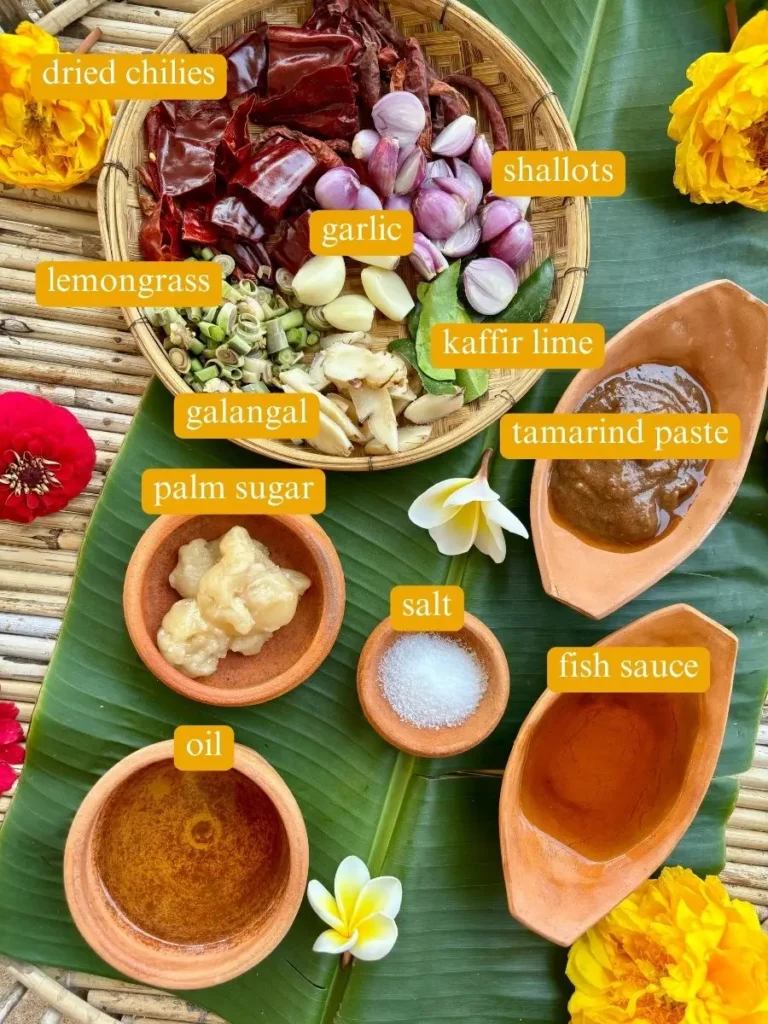
- Large dried chilies (0.4 oz) – I used Guajillo chili. These are rich in chili flavor and color, with mild heat that’s more about depth than spiciness.
- Dried chilies (0.1 oz) – These are what bring the real spice; they add concentrated heat and a hint of smokiness to the paste.
- Shallots (1/3 cup)
- Garlic (4 cloves)
- Kaffir lime leaves (2)
- Lemongrass (3 tbsp)
- Galangal (3 tbsp) – Adds sharp, peppery notes and earthy depth that’s distinct from ginger.
- Fish sauce (5 tbsp) – A key ingredient in Thai cuisine for saltiness and umami. My favorite is Megachef.
- Palm sugar (3 tbsp) – A natural sweetener that brings mellow caramel notes and balances the heat.
- Tamarind paste (5 tbsp) – I recently updated this recipe by swapping out fresh lime juice for tamarind paste—it gives a deeper, tangier sourness that really brings out the classic flavor
- Salt (1 tsp)
How to make tom yum paste
If using a food processor
Step 1: Add all the ingredients to your food processor. Blend until you get a smooth, fiery red paste.

Step 2: Heat oil in a skillet over medium heat. Add the paste and fry for about 2 minutes, just until fragrant.
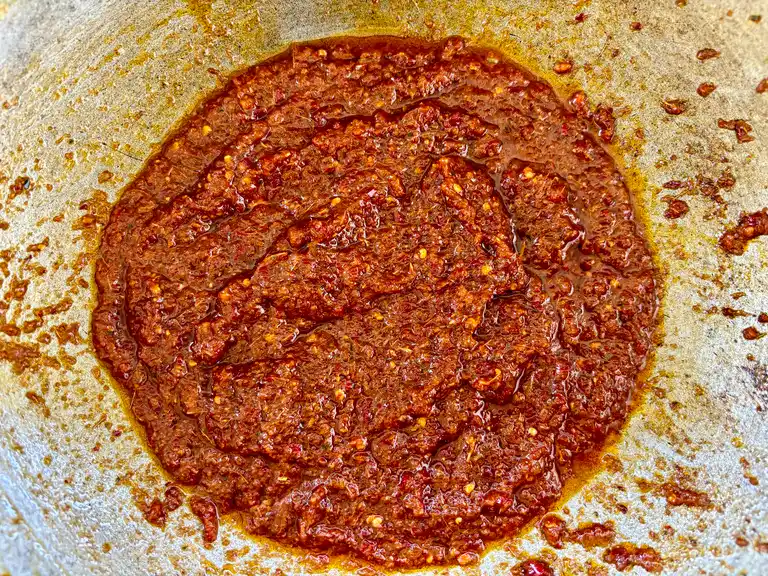
If using a mortar and pestle
Step 1: Soak the dried red chilies in lukewarm water for about 20 minutes, or until softened. This makes the chilies easier to pound.
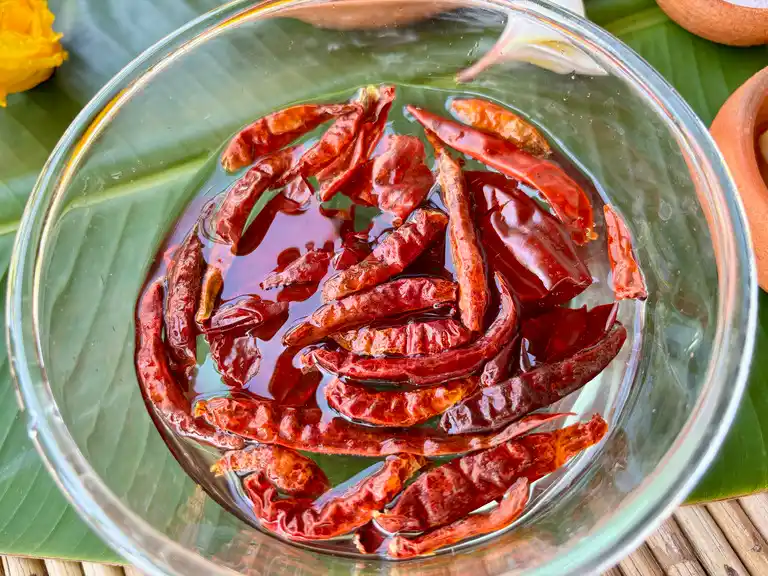
Step 2: In a stone mortar and pestle, start by pounding the dry and fibrous ingredients: lemongrass, salt, galangal, and kaffir lime leaves. Once finely crushed, add the soaked chilies, garlic, and shallots. Pound everything into a smooth paste.
Step 3: Mix in the fish sauce, palm sugar, and tamarind paste. Keep pounding until the sugar is fully dissolved and everything is well combined.
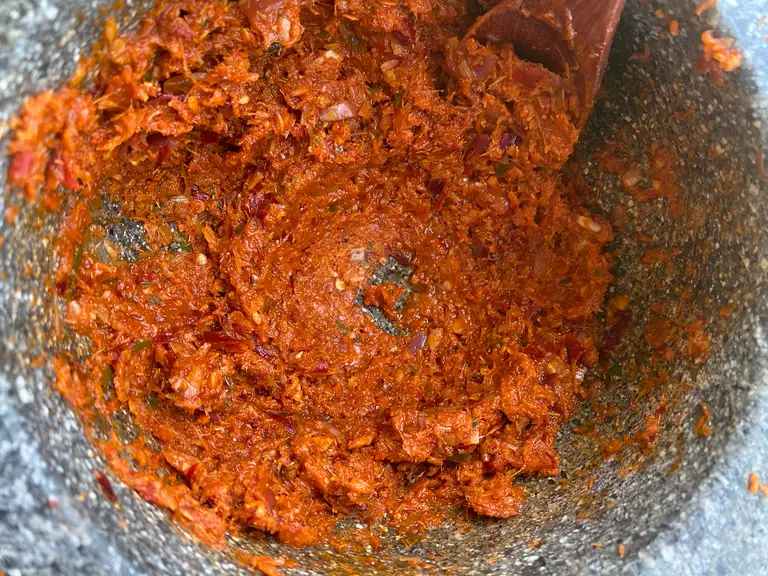
Step 4: Heat oil in a skillet, wok, or pot over low to medium heat. Add the paste and fry for about 2 minutes until it smells rich and fragrant. This step deepens the flavor and helps preserve the paste.
How to use it
Here are some of my favorite ways to use tom yum paste:
- Boost your soups
- Add to salad dressings
- Spread on toast
- Make a dipping sauce
- Use as a marinade – Rub onto chicken, pork, or shrimp before grilling or roasting.
- Toss into stir-fries – Works great with noodles, vegetables, tofu, or any protein. It brings the bold flavor you’d expect from real Thai food, no extra sauces needed!
Storage tips
- Refrigerate: Store in an airtight container or mason jar for up to 2 weeks.
- Freeze: Freeze in portions (like ice cube trays) for up to 3 months. Just thaw what you need!
Related Thai recipes you’ll love
This tom yum paste recipe is the same one we used at my Thai restaurant! Let me know what you think in the comments, and don’t forget to leave a star rating! Follow me on Facebook, Instagram, and Pinterest.
Tom Yum Paste Recipe

Equipment
- Cutting board and sharp knife
- Food processor or stone mortar and pestle
Ingredients
- 0.4 oz or about 8 large dried chilies, see notes
- 0.1 oz or about 6 dried chilies, see notes
- 1 oz or 3 tbsp lemongrass, chopped
- 1 oz or 3 tbsp galangal, chopped
- 2 kaffir lime leaves, stems removed
- 4 cloves of garlic, chopped
- 1/3 cup shallots, chopped
- 5 tbsp fish sauce
- 3 tbsp palm sugar
- 2/3 cup oil
- 5 tbsp tamarind paste
- 1 tsp salt
Instructions
If using a food processor:
- Add all ingredients to a food processor. Blend into a smooth, red paste.
- Heat oil in a skillet over medium heat. Add the paste and fry for 2 minutes until fragrant. Let it cool down before storing.
If using a mortar and pestle:
- Soak dried chilies in lukewarm water for 20 minutes until softened.
- Pound lemongrass, galangal, kaffir lime leaves, and salt into a fine paste.
- Add the soaked chilies, garlic, and shallots. Continue pounding until smooth.
- Mix in fish sauce, palm sugar, and tamarind paste. Stir until the sugar is fully dissolved.
- Heat oil in a skillet over medium heat. Fry the paste for about 2 minutes until fragrant. Let it cool down before storing.
Notes
- Use the nutrition card in this recipe as a guideline.
- Large dried chilies - I used Guajillo chili. These are rich in chili flavor and color, with mild heat that’s more about depth than spiciness.
- Dried chilies - These are what bring the real spice; they add concentrated heat and a hint of smokiness to the paste.





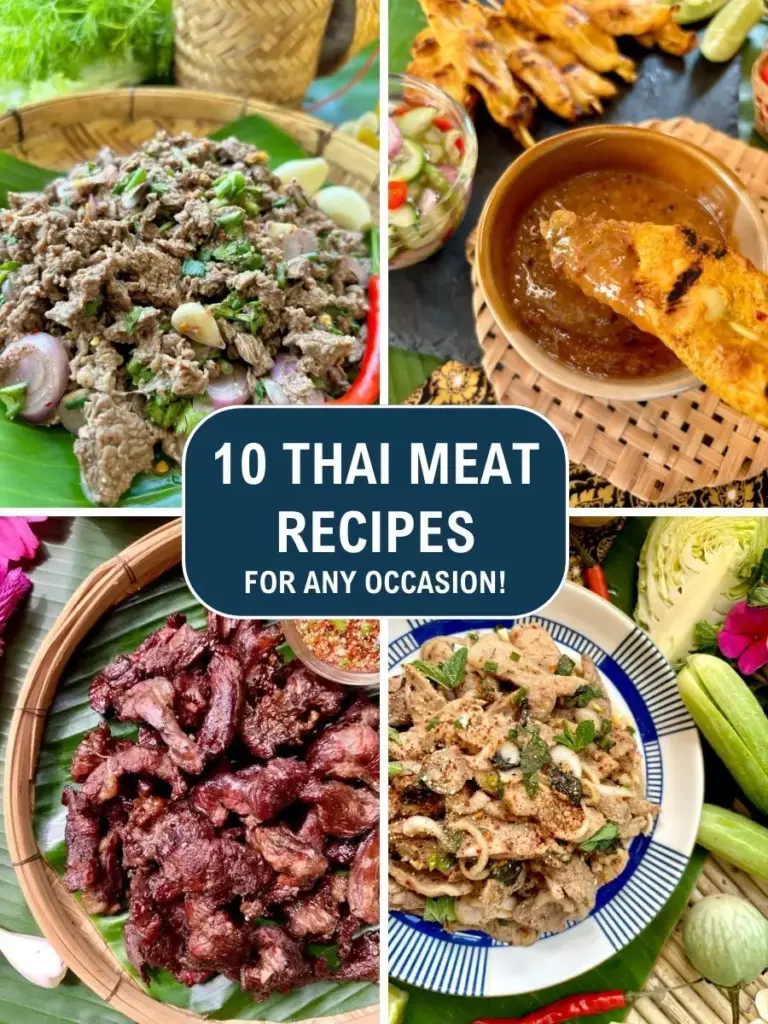
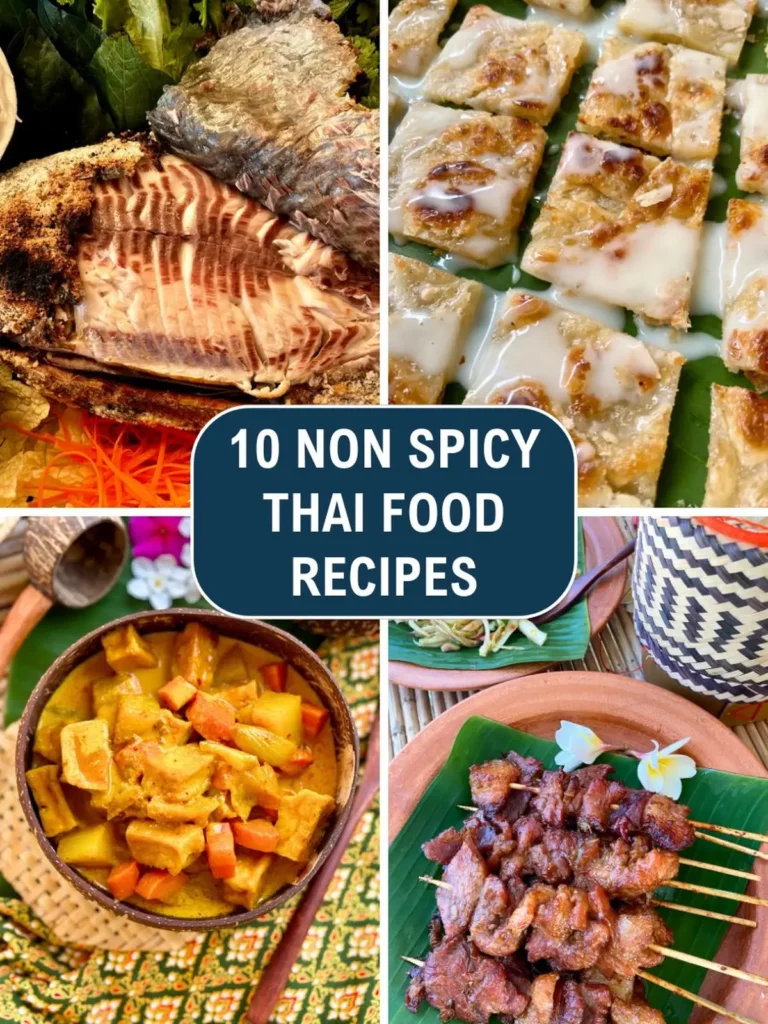
Looks amazing. I plan to give it a try!!
Thank you Dennis, enjoy!
I love making your seafood tom yum soup. The Tom Yum paste is so versatile. I use it in lots of things.. Delicious!
Thank you so much for leaving a comment, Vicki!
Before I try this, I want to double check the amounts. Are these amounts accurate? .42 ounces (12 grams!) of large chili pepper? .1 ounce (3 grams) of small dried chilis? The lemon grass and galangal is twice as much.
I’m a little bit confused by the amounts. Thank you for your help!
Claire
Hey Claire, the amounts are correct. The large chili peppers add lots of chili flavor, but not much spiciness. Small dried chilies are for spice. Enjoy!
Hello Praew. Thank you for this interesting recipe.
Just now dipping my toe into making tom yum paste, and am planning to use your recipe as a base. I have one question: what size mortar do you use?
Thank you.
Hey Mike! I typically use a medium-sized mortar and pestle since I cook for a family of 2. For this recipe, I recommend a clay mortar and pestle. I believe a 5-cup capacity should give you enough space to grind the ingredients! I calculated the total volume of the ingredients gathered for you: 4.60 cups. Please let me know how the recipe turns out!
Merci de partager des recettes tradiionnels
Thank you for leaving a comment!
This recipe is exactly what I’ve been needing! Adds so much flavor and is easily customizable when adding to bowls which is helpful with kids, and a husband who likes it way spicier than I do. Thank you!
Thank you so much for leaving a comment!
Hi,I want to make this recipe from you this weekand and do have a question please. How many of this paste do u use for one good cup of soup ? What else do u add to this paste when making this soup like coconut milk, champignons,coriander,galanga,laos,cherry tomatoes,chicken,peppers, red onion,etc ?
Thank u very much for your recipe and very curious what it tastes like.
When buying a soup in a toko or restaurant it is always ready within 5 minutes or so because of the amazing tom yum paste offcourse they make beforehand. I am often amazed by the taste. I like it spicy.
Hey Erik! I highly suggest making this paste in combination with my tom yum recipe: https://hungryinthailand.com/tom-yum-talay-recipe-thai-seafood-soup/
That recipe specifies exactly how much of the tom yum paste to use (in the recipe card at the end of the post), and all other ingredients for making a delicious soup.
Hello I am excited to try this. Just wondering where you find galangal? Can I buy the dried root on amazon? Or does it have to be fresh?
Hey! You can find fresh galangal at some Asian grocery stores, especially Thai, Vietnamese, or Indonesian ones. You can also use the dried ones found on Amazon. Enjoy!
This was super easy to make and incredibly flavorful. I made enough to freeze some for other dishes.
Thank you so much!
Loved this recipe! Tom Yum is such a comforting dish, and your homemade paste version looks incredibly fresh and authentic. I truly appreciate how you’ve broken it down so it’s easy even for those of us outside Thailand to try it at home. I’ve been exploring clean, Asian-inspired cooking myself through my work with Mekhala Living, so it’s always exciting to come across such beautifully explained traditional recipes. Thanks for sharing!
Thank you so much!